Associated angles α and π/2 + α in trigonometry
In trigonometry, the angles alpha (α) and π/2 + α are known as associated angles, and their transformation formulas are as follows: $$ \sin( \frac{ \pi }{2} + \alpha) = \cos(\alpha) $$ $$ \cos( \frac{ \pi }{2} + \alpha) = -\sin(\alpha) $$ $$ \tan( \frac{ \pi }{2} + \alpha) = - \cot(\alpha) $$ $$ \cot( \frac{ \pi }{2} + \alpha) = - \tan(\alpha) $$
Because they are associated angles, the sine, cosine, tangent, and cotangent of these angles share the same absolute values.
Proof and explanation
Let's consider the angle α and the angle π/2 + α on a unit circle.
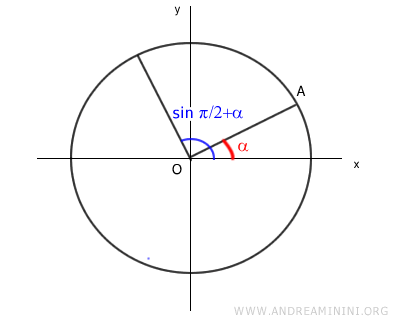
The two angles differ by 90°, or π/2 radians.
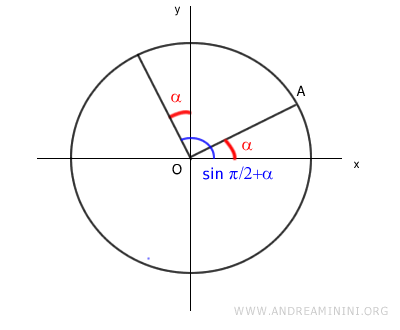
As a result, the right triangles OAB and OCD are congruent (identical) because they share the same acute angle (α) and have the same hypotenuse length (OA = OC).
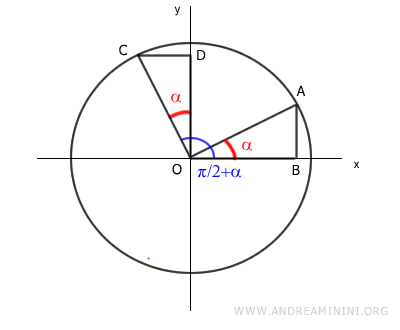
Since the two triangles are congruent, they have the same angles and corresponding side lengths.
The segment OB (cosine of α) is equal to segment OD (sine of π/2 + α).
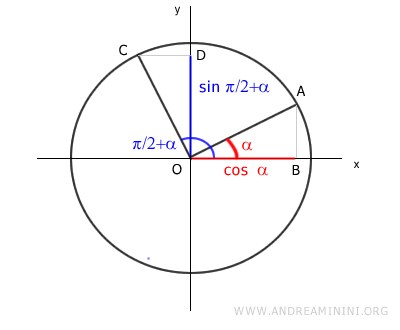
Therefore, the sine of π/2 + α is equal to the cosine of α.
$$ \sin ( \frac{\pi}{2} + \alpha ) = \cos \alpha $$
The segment AB is equal to the segment CD.
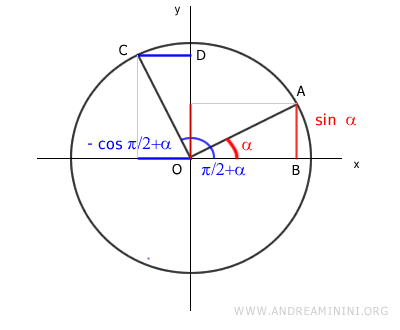
Segment AB represents the sine of α, while segment CD corresponds to the negative cosine of π/2 + α.
$$ \overline{CD} = \overline{AB} $$
$$ - \cos ( \frac{\pi}{2} + \alpha ) = \sin \alpha $$
Multiplying both sides of the equation by -1 gives:
$$ (-1) \cdot - \cos ( \frac{\pi}{2} +\alpha ) = (-1) \cdot \sin \alpha $$
$$ \cos ( \frac{\pi}{2} +\alpha ) = - \sin \alpha $$
Thus, the cosine of π/2 + α is equal to the negative sine of α.
$$ \cos ( \frac{\pi}{2} + \alpha ) = - \sin \alpha $$
With the transformation formulas for sine and cosine in mind, we can also derive the formulas for tangent and cotangent.
The tangent is defined as the ratio of sine to cosine.
$$ \tan ( \frac{\pi}{2} + \alpha ) = \frac{ \sin (\frac{\pi}{2} + \alpha) }{ \cos (\frac{\pi}{2} + \alpha) } $$
Knowing that sin(π/2 + α) = cos(α) and cos(π/2 + α) = -sin(α)
$$ \tan ( \frac{\pi}{2} + \alpha ) = \frac{ \cos \alpha }{ - \sin \alpha } = - \cot \alpha $$
Therefore, the tangent of π/2 + α equals the negative cotangent of α.
The cotangent is defined as the ratio of cosine to sine.
$$ \cot ( \frac{\pi}{2} + \alpha ) = \frac{ \cos (\frac{\pi}{2} + \alpha) }{ \sin (\frac{\pi}{2} + \alpha) } $$
Since sin(π/2 + α) = cos(α) and cos(π/2 + α) = -sin(α)
$$ \cot ( \frac{\pi}{2} - \alpha ) = - \frac{ \sin \alpha }{ \cos \alpha } = \tan \alpha $$
Hence, the cotangent of π/2 + α equals the negative tangent of α.
A practical example
Let’s calculate the sine of 150°.
$$ \sin 150° $$
We can express 150° as the sum of 90° + 60°.
$$ \sin 150° = \sin (90° + 60°) $$
In radians, this becomes:
$$ \sin 150° = \sin (\frac{\pi}{2} + \frac{\pi}{3} ) $$
The angles π/2 + α and α are associated, where α = π/3 (or 60°).
$$ \sin( \frac{\pi }{2} + \alpha ) = \cos(\alpha) $$
So, the sine of 150° is equal to the cosine of 60°.
$$ \sin 150° = \cos( \frac{\pi}{3} ) $$
Since the cosine of 60° is 1/2, the sine of 150° is also 1/2.
$$ \sin 150° = \frac{1}{2} $$
$$ \sin 150° = \frac{1}{2} $$
And that’s the result.
